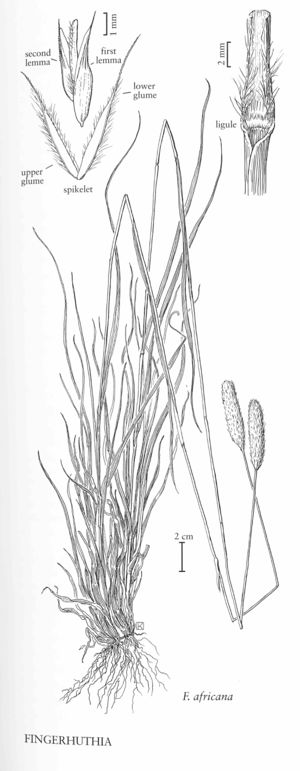Difference between revisions of "Fingerhuthia africana"
Common names: Thimblegrass Zulu fescue
Treatment appears in FNA Volume 25. Treatment on page 22.
imported>Volume Importer |
imported>Volume Importer |
||
| Line 39: | Line 39: | ||
|publication year= | |publication year= | ||
|special status= | |special status= | ||
| − | |source xml=https://bitbucket.org/aafc-mbb/fna-data-curation/src/ | + | |source xml=https://bitbucket.org/aafc-mbb/fna-data-curation/src/200273ad09963decb8fc72550212de541d86569d/coarse_grained_fna_xml/V25/V25_28.xml |
|subfamily=Poaceae subfam. Chloridoideae | |subfamily=Poaceae subfam. Chloridoideae | ||
|tribe=Poaceae tribe Cynodonteae | |tribe=Poaceae tribe Cynodonteae | ||
Latest revision as of 18:58, 11 May 2021
Plants cespitose and shortly rhizomatous. Culms 10-95 cm. Blades 2.5-40 cm long, 2-4 mm wide, scabrous distally. Panicles 1.5-5 cm, cylindrical or ovoid, cuneate below. Spikelets 4-5.5 mm. Glumes narrowly elliptic, ciliate on the keel and the distal portion of the margins; lowest lemmas 3.5-4 mm, glabrous, sometimes scabridulous, margins ciliate, apices obtuse and abruptly mucronate. 2n = 40.
Discussion
Fingerhuthia africana is native to southern Africa and western Asia. It has been grown at the Santa Rita Experimental Range in Pima County, Arizona, but is not established in the Flora region.
Selected References
None.
Lower Taxa
None.
